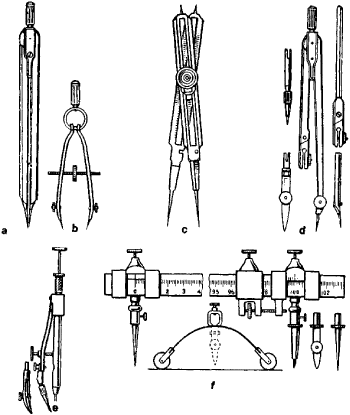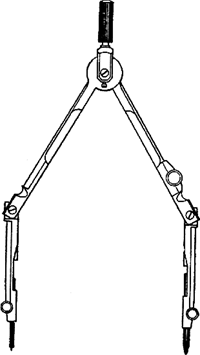Instrument for Drawing Circles Crossword
compass
compass. 1 In mathematics, an instrument for making circles and measuring distances. Frequently called a pair of compasses, information technology consists of two metal legs with one end of each attached to a pivot to form a V-shaped device. The complimentary ends are pointed; a pen or pencil may exist substituted for one of the points. ii In navigation, an instrument for determining direction. The mariner'southward compass consists of a magnetic needle freely suspended and then that in the world's magnetic field information technology turns until aligned with the magnetic due north and south poles. Declination is the bending between the magnetic needle and the geographical height. Use of the compass by the early Chinese is probably legendary. The beginning known reference in European literature dates from the 12th cent. Another more authentic form of navigational compass is the gyrocompass. Information technology consists essentially of a rapidly spinning, electrically driven rotor, suspended in such a mode that its axis automatically points along the geographical meridian. The gyrocompass is unaffected by magnetic influences. This compass came into wide utilize in warships and aircraft during the 2d World State of war. See gyroscope.
The Columbia Electronic Encyclopedia™ Copyright © 2022, Columbia University Press. Licensed from Columbia University Press. All rights reserved.
The following article is from The Great Soviet Encyclopedia (1979). It might exist outdated or ideologically biased.
Compass
a direction-finding instrument. Co-ordinate to principle of operation, a distinction is made amidst magnetic compasses, which use the holding of straight permanent magnets (magnetic pointers) or coils with electric current of assuming a north-southward orientation along a magnetic meridian upon interaction with the earth'due south magnetic field; gyrocompasses, which use the property of a rapidly spinning gyroscope rotor of maintaining a constant direction of its axis of rotation, which, under certain conditions, remains in the airplane of a geographic meridian; angelic compasses, in which a special device (a management finder) continuously tracks the location of some celestial body (for example, the sun), making possible decision of the direction of the geographic meridian if the geographic coordinates of the location are known; and radio compasses, which are radio receiving devices that automatically lock in the direction toward a radio beacon. Compasses are used in maritime and aircraft navigation (to determine the course of a vessel or aircraft and to find the direction toward a reference indicate), in overland travel, in armed services affairs, and in geodesy, topography, and mining.
The oldest and virtually widely known type of compass is the magnetic type. Permanent magnets were used in People's republic of china more than 2,000 years agone to determine the north-south management. In Europe the compass appeared non later than the 12th century; information technology consisted of a magnetic pointer attached to a cork floating in a water-filled vessel. During the early office of the 14th century the compass was improved: the magnetic pointer was placed on a indicate located in the centre of a paper circle (a compass rose), which was graduated for convenient reading. The circumvolve was subdivided first into 16 and later on 32 equal sectors.
In the 16th century a gimbal interruption was introduced to reduce mechanical vibrations (for case, during rolling and pitching at ocean). In the 17th century marine compasses were equipped with a direction finder—a rotating rule with sights at both ends—which facilitated accurate reading of directions or bearings. The improved magnetic compass became the main navigational musical instrument for determining the class of a ship. The reading accuracy of currently used ship's magnetic compasses in medium latitudes and in the absenteeism of pitch and scroll can reach 0.3°˗0.5°.
An aircraft magnetic compass has the same basic parts every bit a transport's compass, but the aircraft blueprint takes into business relationship some operational conditions peculiar to this type of service, such every bit possible strong vibrations and accelerations.
Amidst the disadvantages of a magnetic compass are the demand to introduce reading corrections to compensate for the noncoincidence of the magnetic and geographic meridians (consideration of magnetic declination) and for difference. Near the earth'south magnetic poles and potent magnetic anomalies the accuracy of the readings of a magnetic compass is drastically reduced; in such localities other types of compasses must be used. Notwithstanding, none of the types mentioned above can provide an accurate course reading in all areas of the globe, under any weather conditions, and for any state of the magnetosphere and radio interference level. For this reason it is customary in marine and air travel and military affairs to use a combination of several types of compasses; consolidated grade-finding systems are based on such combined utilize.
REFERENCES
Anderson, E. Printsipy navigatsii. Moscow, 1968. (Translated from English.)
Seleznev, V. P. Navigatsionnye ustroistva. Moscow, 1961.
Compass
(in Russian, krontsirkul' ), a cartoon instrument for constructing circles 2–80 mm in diameter. At that place are drawing compasses with a screw joint between the measuring legs, as well equally compasses that have a vertically mounted back up leg and a movable measuring leg, whose position is fixed by a screw (the balerinka, or "little ballerina").
Compass
(in Russian, tsirkul'), an instrument used to draw circles or arcs, to measure the lengths of line segments, to transfer dimensions, or to scale measured dimensions up or down.
The post-obit main types of compasses are distinguished: dividers, drawing compasses, bow compasses, beam compasses, and proportional compasses (see Effigy ane). Dividers, which practise not take a pen or pencil point, are used to mensurate or transfer linear dimensions. Cartoon compasses are employed to depict circles with diameters of up to 300 mm; bow compasses, circles with diameters of ii to 80 mm; and beam compasses, circles with diameters of more than 300 mm. Proportional compasses make it possible to change the scale of measured dimensions.

Figure 1. Compasses: (a) divider, (b) bow compass, (c) proportional compass, (d) drawing compass, (e) drop compass (the balerinka, or "trivial ballerina"), (f) beam compass
Based on the prove of drawn circles that have been preserved, the ancient Babylonians and Assyrians used compasses. In France, an iron compass was discovered in a Gallic barrow dating from the first century of the Common Era. Many bronze compasses used by the Romans during the first century of the Common Era were found in the ruins of Pompeii; they stand for all the modernistic types of compasses. In addition to unproblematic compasses, the Roman instruments include proportional compasses for enlarging or reducing the calibration of measured dimensions and calipers for measuring the within and outside diameters of objects.
In aboriginal Rus', a compass-drawn ornament consisting of tiny perfect circles was widely used on articles made of os. A compasslike steel cutter for scribing the ornament was found during archaeological excavations in Novgorod.
The Smashing Soviet Encyclopedia, 3rd Edition (1970-1979). © 2010 The Gale Group, Inc. All rights reserved.
What does information technology mean when you dream almost a compass?
Guidance. Finding one's way out of situation in which one feels lost. We besides talk about our "moral compass," which guides us in making ethical choices.
The Dream Encyclopedia, Second Edition © 2009 Visible Ink Press®. All rights reserved.
compass
[′käm·pəs](engineering)
An musical instrument for indicating a horizontal reference direction relative to the world.
(graphic arts)
An musical instrument used for describing arcs or circles with pencil or pen; has 2 legs hinged together at the acme.
McGraw-Colina Lexicon of Scientific & Technical Terms, 6E, Copyright © 2003 past The McGraw-Hill Companies, Inc.
compass

compass
An instrument for drawing circles, measuring the distance betwixt two points, etc.; consists of ii pointed legs, movable on a joint or pivot, usually made so that 1 of the points tin can be detached for the insertion of a pen, extension, etc.
McGraw-Hill Dictionary of Architecture and Construction. Copyright © 2003 past McGraw-Colina Companies, Inc.
compass
1. an instrument used for drawing circles, measuring distances, etc., that consists of two arms, joined at ane stop, one arm of which serves as a pin or stationary reference indicate, while the other is extended or describes a circle
2.Music the interval between the lowest and highest note accessible by a vox or instrument
Collins Discovery Encyclopedia, 1st edition © HarperCollins Publishers 2005
COMPASS
This article is provided past FOLDOC - Free Online Dictionary of Calculating (foldoc.org)
rodriguezparacce1990.blogspot.com
Source: https://encyclopedia2.thefreedictionary.com/pair+of+compasses
0 Response to "Instrument for Drawing Circles Crossword"
Enregistrer un commentaire